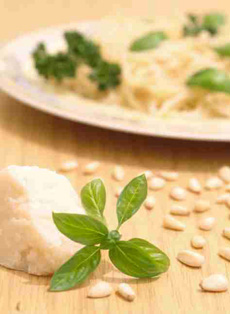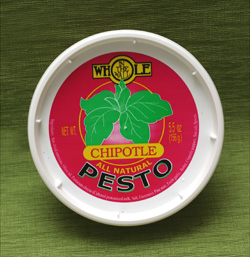

It all starts with basil, parmesan, pine nuts and olive oil.
|
ALISSA DICKER SCHRIEBER is a freelance writer and cooking teacher who resides in New York City.
|
|
January 2007
Updated March 2009
|
 |
Pesto Perfect
The Best Pesto Sauce: Basil Pesto, Cilantro Pesto, Arugula Pesto & Much More
CAPSULE REPORT: We tasted more than 100 pestos from around the world to find the best ones: some shelf-stable, some requiring refrigeration. Some of the best sauces were domestic pestos, showing the craft of American artisans. This is Page 1 of a ten-page article. Click on the black links below to visit other pages.
Overview
While we love to whip up our own sauces, keeping a good jar of pre-made pesto around can make any dish extraordinary in only a matter of minutes. Add a dollop to dinner and suddenly you’re a fancy cook who understands how to dazzle with delicate herbs. Pesto is vegetarian, low in carbs and packed with fresh ingredients: a bright, healthy addition to your meals.
Pesto sauce, which traditionally* consists of basil, garlic, olive oil, pine nuts, Parmesan and Pecorino cheeses and salt for seasoning, originated in the Italian province of Liguria, 220 miles of crescent-shaped Mediterranean coastline that is sometimes called the Italian Riviera. Liguria, the capital of which is Genoa, is home to superb produce, most notably the sweetest, mildest basil. Its people enjoy one of the freshest, healthiest cuisines in all of Italy.
*Delicious pestos can be made with walnuts and hazelnuts as well, and regions that have an abundance of those nuts will make the substitution.
Ligurians take such great pride in their sauce, in fact, that they have sought protective name of origin (D.O.P.) status for pesto produced in the area. This labeling distinguishes a product for its authenticity and excellence—as it has done for bufala mozzarella from Campania, which, incidentally, pairs beautifully with pesto.
In his book, Delizia!: The Epic History of the Italians and Their Food, John Dickie notes that pesto was originally used mostly to flavor vegetable soups. It wasn’t until 1910 that it began to be used as a sauce for pasta. Earlier versions of pesto used parsley or marjoram instead of basil, and did not include the pine nuts.
Today, what we find on supermarket and specialty food store shelves bearing the  name pesto could be anything from a traditional basil blend imported from Liguria, to something made of mushrooms or roasted red peppers. Though purists might cringe at how loosely the word is being used, since there are so many quirky-flavored pestos on the market, we thought it only fair to include them in our taste-test. It was a good thing we didn’t snub these non-textbook varieties—among them were some of the most impressive sauces we tried, like Divine Pasta Company’s Chipotle Pesto (it was so good, we finished it, so the photo at the left shows the Chipotle Pesto from Whole In The Wall, a slightly milder chipotle flavor). And, while not classically called pesto, many of the sauces showcase traditional Ligurian ingredients, like sun-dried tomatoes and garlic. name pesto could be anything from a traditional basil blend imported from Liguria, to something made of mushrooms or roasted red peppers. Though purists might cringe at how loosely the word is being used, since there are so many quirky-flavored pestos on the market, we thought it only fair to include them in our taste-test. It was a good thing we didn’t snub these non-textbook varieties—among them were some of the most impressive sauces we tried, like Divine Pasta Company’s Chipotle Pesto (it was so good, we finished it, so the photo at the left shows the Chipotle Pesto from Whole In The Wall, a slightly milder chipotle flavor). And, while not classically called pesto, many of the sauces showcase traditional Ligurian ingredients, like sun-dried tomatoes and garlic.
Continue To Page 2: The History Of Pesto
Go To The Article Index Above
Lifestyle Direct, Inc. All rights reserved. Images are the copyright of their individual owners.

|





 name pesto could be anything from a traditional basil blend imported from Liguria, to something made of mushrooms or roasted red peppers. Though purists might cringe at how loosely the word is being used, since there are so many quirky-flavored pestos on the market, we thought it only fair to include them in our taste-test. It was a good thing we didn’t snub these non-textbook varieties—among them were some of the most impressive sauces we tried, like Divine Pasta Company’s Chipotle Pesto (it was so good, we finished it, so the photo at the left shows the Chipotle Pesto from Whole In The Wall, a slightly milder chipotle flavor). And, while not classically called pesto, many of the sauces showcase traditional Ligurian ingredients, like sun-dried tomatoes and garlic.
name pesto could be anything from a traditional basil blend imported from Liguria, to something made of mushrooms or roasted red peppers. Though purists might cringe at how loosely the word is being used, since there are so many quirky-flavored pestos on the market, we thought it only fair to include them in our taste-test. It was a good thing we didn’t snub these non-textbook varieties—among them were some of the most impressive sauces we tried, like Divine Pasta Company’s Chipotle Pesto (it was so good, we finished it, so the photo at the left shows the Chipotle Pesto from Whole In The Wall, a slightly milder chipotle flavor). And, while not classically called pesto, many of the sauces showcase traditional Ligurian ingredients, like sun-dried tomatoes and garlic.